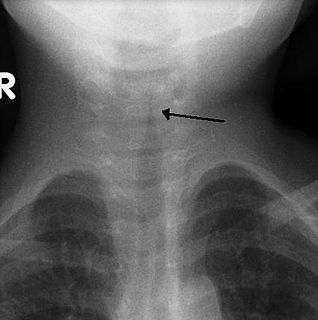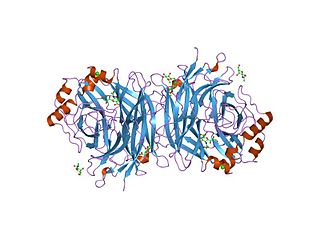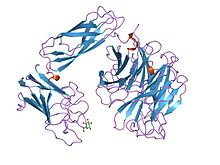
A pilus is a hair-like appendage found on the surface of many bacteria and archaea. The terms pilus and fimbria can be used interchangeably, although some researchers reserve the term pilus for the appendage required for bacterial conjugation. All pili in the latter sense are primarily composed of pilin proteins, which are oligomeric.

Proteobacteria is a major phylum of Gram-negative bacteria. They include a wide variety of pathogenic genera, such as Escherichia, Salmonella, Vibrio, Helicobacter, Yersinia, Legionellales, and many others. Others are free-living (nonparasitic) and include many of the bacteria responsible for nitrogen fixation.

Croup, also known as laryngotracheobronchitis, is a type of respiratory infection that is usually caused by a virus. The infection leads to swelling inside the trachea, which interferes with normal breathing and produces the classic symptoms of "barking" cough, stridor, and a hoarse voice. Fever and runny nose may also be present. These symptoms may be mild, moderate, or severe. Often it starts or is worse at night and normally lasts one to two days.

Haemophilus influenzae is a Gram-negative, coccobacillary, facultatively anaerobic capnophilic pathogenic bacterium of the family Pasteurellaceae. H. influenzae was first described in 1892 by Richard Pfeiffer during an influenza pandemic.
Rhodobacterales are an order of the Alphaproteobacteria.

Neuraminidase (Sialidase) enzymes are glycoside hydrolase enzymes that cleave (cut) the glycosidic linkages of neuraminic acids. Neuraminidase enzymes are a large family, found in a range of organisms. The best-known neuraminidase is the viral neuraminidase, a drug target for the prevention of the spread of influenza infection. The viral neuraminidases are frequently used as antigenic determinants found on the surface of the influenza virus. Some variants of the influenza neuraminidase confer more virulence to the virus than others. Other homologues are found in mammalian cells, which have a range of functions. At least four mammalian sialidase homologues have been described in the human genome . Sialidases may act as pathogenic factors in microbial infections.

Interleukin 3 (IL-3) is a protein that in humans is encoded by the IL3 gene localised on chromosome 5q31.1.

In structural biology, a beta-propeller (β-propeller) is a type of all-β protein architecture characterized by 4 to 8 highly symmetrical blade-shaped beta sheets arranged toroidally around a central axis. Together the beta-sheets form a funnel-like active site.

Streptococcus oralis is a Gram positive bacterium that grows characteristically in chains. It forms small white colonies on a Wilkins-Chalgren agar plate. It is found in high numbers in the oral cavity. It has been classified as a member of the Streptococcus mitis group. Members of this group are opportunistic pathogens. Strains of S. oralis produce neuraminidase and an IgA protease and cannot bind α-amylase.

Arcanobacterium haemolyticum, formerly known as Corynebacterium hæmolyticum, is a species of bacteria classified as a gram-positive bacillus. It is catalase-negative, aerobic, beta-hemolytic, and not motile. It has been known to cause head and neck infections, pharyngitis, and sinusitis.

Cathepsin A is an enzyme that is classified both as a cathepsin and a carboxypeptidase. In humans, it is encoded by the CTSA gene.

Galactosidase, beta 1, also known as GLB1, is a protein which in humans is encoded by the GLB1 gene.
Coarse facial features or coarse facies describes a constellation of facial features that are present in many inborn errors of metabolism.

Viral neuraminidase is a type of neuraminidase found on the surface of influenza viruses that enables the virus to be released from the host cell. Neuraminidases are enzymes that cleave sialic acid groups from glycoproteins. Neuraminidase inhibitors are antiviral agents that inhibit influenza viral neuraminidase activity and are of major importance in the control of influenza.

In molecular biology, hemagglutinin or haemagglutinin are glycoproteins which cause red blood cells (RBCs) to agglutinate or clump together. It mostly happens when adding influenza virus to erythrocytes, just as virologist George K. Hirst discovered in 1941, even though it can also occur with measles virus, parainfluenza virus and mumps virus, among others. Time after, more related discoveries were made such as when Alfred Gottschalk proved in 1957 that hemagglutinin links virus in order to host cells by attaching sialic acids on carbohydrate side chains of cell-membrane glycoproteins and glycolipids.

Hemagglutinin-neuraminidase refers to a single viral protein that has both hemagglutinin and (endo) neuraminidase EC 3.2.1.18 activity. This is in contrast to the proteins found in influenza, where both functions exist but in two separate proteins. Its neuraminidase domain has the CAZy designation glycoside hydrolase family 83 (GH83).
Parainfluenza hemagglutinin-neuraminidase is a type of hemagglutinin-neuraminidase produced by parainfluenza.

BNR/Asp-box repeat is a repetitive sequence of amino acids contained in some proteins.
Micromonospora viridifaciens is an endophytic actinomycete, with type strain DSM 43909T.
Nikos Kyrpides is an American bioscientist of Greek descent who has worked on the origins of life, information processing, bioinformatics, microbiology, metagenomics and microbiome data science. He is a senior staff scientist at the Berkeley National Laboratory, head of the Prokaryote Super Program and leads the Microbiome Data Science program at the US Department of Energy Joint Genome Institute.














